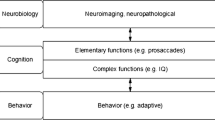Abstract
Overall, the evidence from over 100 twin and adoption studies of antisocial behavior suggests that genetic factors account for about half of the variation in risk. However, behavioral genetic studies of antisocial behavior still tend to produce far-ranging estimates of heritability, suggesting that there may be important moderators of these genetic risk factors. In this review, the results of some recent behavioral genetic studies of antisocial behavior that focus on the following issues are examined: 1) developmental changes in the heritability of antisocial behaviors, 2) developmental subtypes of antisocial behavior disorders, 3) sex differences in the heritability of antisocial behavior, 4) cohort differences in the heritability of antisocial behavior, and 5) the genetics of antisocial behavior comorbidity.
Similar content being viewed by others
References and Recommended Reading
Rhee SH, Waldman ID: Genetic and environmental influences on antisocial behavior: a meta-analysis of twin and adoption studies. Psychol Bull 2001, in press. The authors conduct a careful quantitative synthesis of 51 twin and adoption studies of antisocial behavior, and examine the effect of several moderator variables including sex, age, definition of antisocial behavior used, and study design.
Kendler KS: Overview: a current perspective on twin studies of schizophrenia. Am J Psychiatry 1983, 140:1413–1425.
Sullivan PF, Neale MC, Kendler, KS: The genetic epidemiology of major depression: review and meta-analysis. Am J Psychiatry 2000, 157:1552–1562.
Waldman ID, Slutske WS: Antisocial behavior and alcoholism: a behavioral genetic perspective on comorbidity. Clin Psychol Rev 2000, 20:255–287.
Thapar A, Holmes J, Poulton K, Harrington R: Genetic basis of attention deficit and hyperactivity. Br J Psychiatry 1999, 174:105–111.
Cloninger CR, Gottesman II: Genetic and environmental factors in antisocial behavior disorders. In The Causes of Crime: New Biological Approaches. Edited by Mednick SA, Moffitt TE, Stack SA. Cambridge: Cambridge University Press; 1987:92–109.
Lyons MJ, True W, Eisen S, et al.: Differential heritability of adult and juvenile antisocial traits. Arch Gen Psychiatry 1995, 52:906–915.
Jacobson KC, Prescott CA, Kendler KS: Sex differences in the genetic and environmental influences on the development of antisocial behavior. Dev Psychopathol 2001, in preparation.
Lyons MJ: A twin study of self-reported criminal behavior. In Genetics of Criminal and Antisocial Behavior. Edited by Bock GR, Goode JA. Chichester: John Wiley & Sons; 1996:61–86.
American Psychiatric Association: Diagnostic and Statistical Manual of Mental Disorders, edn 4: DSM-IV. Washington, DC: American Psychiatric Association; 1994.
Lahey BB, Loeber R, Quay HC, et al.: Oppositional defiant disorder and conduct disorder. In DSM-IV Sourcebook, vol 3. Edited by Widiger TA, Frances AJ, Pincus HA, et al.: Washington, DC: American Psychiatric Association; 1997:189–209.
Hinshaw SP: Conduct disorder in childhood: conceptualization, diagnosis, comorbidity, and risk status for antisocial functioning in adulthood. In Progress in Experimental Personality & Psychopathology Research. Edited by Fowles DC, Sutker P, Goodman SH. New York: Springer; 1994:3–44.
Moffitt TE, Caspi A, Dickson N, et al.: Childhood-onset versus adolescent-onset antisocial conduct problems in males: natural history from ages 3 to 18 years. Dev Psychopathol 1996, 8:399–424.
Loeber R: Natural histories of conduct problems, delinquency, and associated substance use: evidence for developmental progressions. Adv Clin Child Psychol 1988, 11:73–124.
Moffitt TE: Adolescence-limited and life-course-persistent antisocial behavior: a developmental taxonomy. Psychol Rev 1993, 100:674–701.
DiLalla LF, Gottesman II: Heterogeneity of causes for delinquency and criminality: lifespan perspectives. Dev Psychopathol 1989, 1:339–349.
Slutske WS, Lyons MJ, True WR, et al.: Testing a developmental taxonomy of antisocial behavior. In Paper presented at the Behavior Genetics Association meeting. Toronto, Canada: July 10–13, 1997.
Miles DR, Carey G: Genetic and environmental architecture of human aggression. J Personal Soc Psychol 1997, 72:207–217. A quantitative synthesis of 24 twin and adoption studies of aggression.
Slutske WS, Heath AC, Dinwiddie SH, et al.: Modeling genetic and environmental influences in the etiology of conduct disorder: a study of 2682 adult twin pairs. J Abnorm Psychol 1997, 106:266–279.
Cloninger CR, Christiansen KO, Reich T, Gottesman II: Implications of sex differences in the prevalences of antisocial personality, alcoholism, and criminality for familial transmission. Arch Gen Psychiatry 1978, 35:941–951.
Jacobson KC, Prescott CA, Neale MC, Kendler KS: Cohort differences in genetic and environmental influences on retrospective reports of conduct disorder among male adult twins. Psychol Med 2000, 30:775–787.
Silberg J, Rutter M, Meyer J, et al.: Genetic and environmental influences on the covariation between hyperactivity and conduct disturbance in juvenile twins. J Child Psychol Psychiatry 1996, 37:803–816.
Slutske WS, Heath AC, Dinwiddie SH, et al.: Common genetic risk factors for conduct disorder and alcohol dependence. J Abnorm Psychol 1998, 107:363–374.
Jang KL, Vernon PA, Livesley WJ: Personality disorder traits, family environment, and alcohol misuse: a multivariate behavioural genetic analysis. Addiction 2000, 95:873–888.
Slutske WS, Eisen SA, Xian H, et al.: A twin study of the association between pathological gambling and antisocial personality disorder. J Abnorm Psychol 2001, in press.
Young SE, Stallings MC, Corley RP, et al.: Genetic and environmental influences on behavioral disinhibition. Am J Med Genet (Neuropsychiatr Genet) 2000, 96:684–695. Using multivariate behavioral genetic statistical techniques, the authors identify a highly heritable latent trait of behavioral disinhibition that may be useful as a phenotype in molecular genetic studies.
Author information
Authors and Affiliations
Rights and permissions
About this article
Cite this article
Slutske, W.S. The genetics of antisocial behavior. Curr Psychiatry Rep 3, 158–162 (2001). https://doi.org/10.1007/s11920-001-0014-1
Issue Date:
DOI: https://doi.org/10.1007/s11920-001-0014-1




